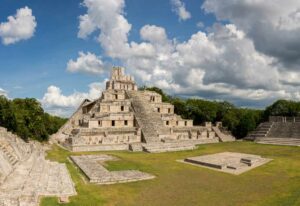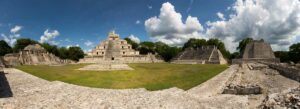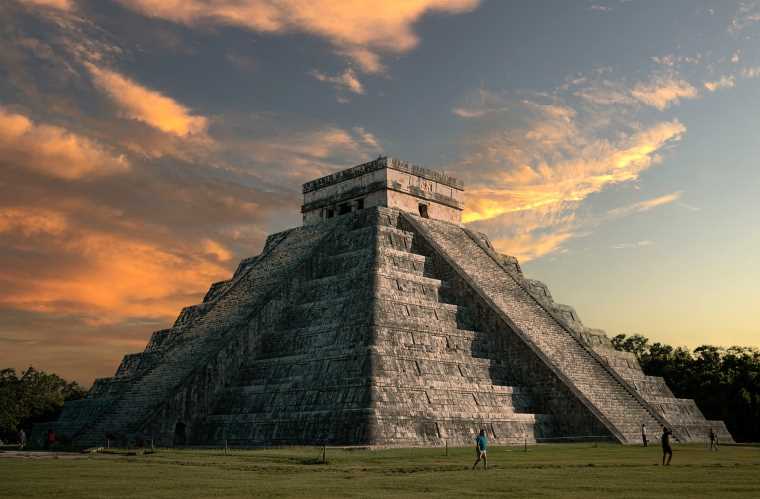Using advanced lidar imagery, researchers from Tulane University have discovered over 6,500 unexplored ancient Mayan settlements hidden beneath dense Mexican jungle forests.
The researchers say their findings only scratch the surface of the settlements that likely populate the country’s unexplored landscape.
The team involved with the historic discovery employed lidar technology to scan a 50-square-mile section of the overgrown landscape in Campeche, Mexico. Like radar, which uses radio waves to image objects, lidar employs laser pulses that bounce off different materials at different rates. These reflected pulses allow researchers to peer beneath the surface of several types of terrains, including jungle forests, by creating a three-dimensional map of hidden structures invisible to the human eye.


That analysis revealed a “vast unexplored” network of ancient Mayan settlements hidden by dense overgrowth. Among the previously unknown ancient Hispanic structures was a large city with stone pyramids reminiscent of previously discovered iconic ancient Mayan pyramids.
“Our analysis not only revealed a picture of a region that was dense with settlements, but it also revealed a lot of variability,” said Luke Auld-Thomas, a doctoral student in Tulane’s Anthropology Department and instructor at Northern Arizona University. “We didn’t just find rural areas and smaller settlements. We also found a large city with pyramids right next to the area’s only highway, near a town where people have been actively farming among the ruins for years.”


Ancient Mayan Settlements in Area Largely Ignored by Archaeologists
Ironically, the researchers said archaeologists, including those specializing in Mayan history, had largely ignored the targeted area.
“The government never knew about it; the scientific community never knew about it,” said Auld-Thomas. “That really puts an exclamation point behind the statement that, no, we have not found everything, and yes, there’s a lot more to be discovered.”
Along with its cultural and historical significance, the discovery of such an extensive network of ancient Mayan settlements shows how lidar technology has dramatically altered the landscape of archaeology. In this case, the technology was provided by The Middle American Research Institute (MARI) at Tulane University, which has spent the last ten years expanding and improving lidar’s application.


“Thanks to generous funding from the Hitz Foundation, MARI has been at the forefront of the use of lidar technology in archaeological research over the past decade,” said Professor Marcello A. Canuto, director of the MARI and Auld-Thomas’ advisor. “Now, our efforts are expanding from data analysis to data collection and acquisition. The work conducted on these data from Campeche represents how MARI’s ‘lidar footprint’ is expanding.”
“Because lidar allows us to map large areas very quickly, and at really high precision and levels of detail, that made us react, ‘Oh wow, there are so many buildings out there we didn’t know about, the population must have been huge,’” added Auld-Thomas.


According to the team’s published study, their findings contradict much of mainstream Mayan research, which “was too tethered to” the larger previously discovered settlements such as Takil. Instead, their work looked at the rural areas outside those regions with the idea that Mayan civilization may have been more spread out than previously thought, leaving a vast area of undiscovered architecture waiting to be found.
“What if the rest of the Maya area was far more rural and what we had mapped so far was the exception instead of the rule?” Auld-Thima postulated.
Understanding How the Maya Maintained a Complex Society
Follow-up studies, including field expeditions, will be needed to perform a more detailed analysis of the structures. However, the researchers believe their discovery of such a large number of ancient Mayan structures in a previously disregarded area likely means that many more structures are waiting to be discovered. They also feel that this discovery offers a much more complex picture of ancient Mayan society, including how they likely used a form of urban planning to support such a complex civilization.
“Lidar is teaching us that, like many other ancient civilizations, the lowland Maya built a diverse tapestry of towns and communities over their tropical landscape,” Canuto said. “While some areas are replete with vast agricultural patches and dense populations, others have only small communities. Nonetheless, we can now see how much the ancient Maya changed their environment to support a long-lived complex society.”
The study “Running out of Empty Space: Environmental Lidar and the Crowded Ancient Landscape of Campeche, Mexico” was published in Antiquity.
Christopher Plain is a Science Fiction and Fantasy novelist and Head Science Writer at The Debrief. Follow and connect with him on X, learn about his books at plainfiction.com, or email him directly at christopher@thedebrief.org.

